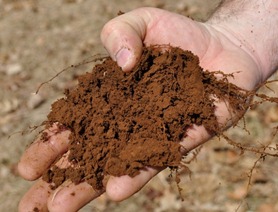Wearing the Skin Off the Earth
 Everything that grows from the earth naturally is created from the nutrients in topsoil, the fertile earth – three feet deep on average — that used to cover much of the terrestrial part of the planet. Everything we eat and the air we breathe comes directly or indirectly from the plants that root and feed on topsoil. So it is pretty disturbing to learn that we are destroying top soil globally at the rate of one per cent a year. By now, farm states like Iowa find themselves with half their top soils gone. America is using up its topsoil 10 times faster than it can be replaced. The factor for China is 57.
Everything that grows from the earth naturally is created from the nutrients in topsoil, the fertile earth – three feet deep on average — that used to cover much of the terrestrial part of the planet. Everything we eat and the air we breathe comes directly or indirectly from the plants that root and feed on topsoil. So it is pretty disturbing to learn that we are destroying top soil globally at the rate of one per cent a year. By now, farm states like Iowa find themselves with half their top soils gone. America is using up its topsoil 10 times faster than it can be replaced. The factor for China is 57.
It takes a century to build an inch of topsoil – for the natural processes that create fertile soil to take hold. It involves a veritable community of microorganisms: several kinds of bacteria, of fungi, of protozoans, that consume the mineral materials and plant detritus on the surface and turn it into nutrients that plants can use. If you pick up a handful of viable topsoil, you hold millions of microscopic creatures engaged in their life processes that make the soil fertile.
Topsoil is destroyed in several ways. Some of it is paved or built over, but most of the topsoil we lost is either over-farmed or overgrazed. Over-farming is the most serious cause in Europe and the United States, where large areas a farmed intensively without letting the soil recover from the loss of nutrients that have gone into the crop. The loss is increased by repeated tillage, where the soil is turned over for each crop so that it is exposed to wind and heavy rain, and blown or washed away.
In Africa, the main reason for the loss of topsoil is overgrazing, where too many animals graze the same land repeatedly, preventing the grasses that the animals eat from recovering. Unable to regenerate their leaves from photosynthesis, the plants use up the nutrients from their soil. The depleted soil washes or blows away. The red dust storms of Australia and the gray dust storms that obscure the streets of Beijing have their origin in dead soils that contain no organic matter to create a matrix to hold them and encounter a dry, windy period.
Methods to preserve topsoil are well known. No-till farming, where the soil is only tilled where and when the intended crop is planted – as opposed to turning the soil over completely to a depth of several inches. There is contour plowing, where the furrows run perpendicular to the pitch of the land. There are cover crops that take root and hold the earth in place through the winter, preventing erosion and permitting natural processes to continue within the earth. There is leaving crop residues like plant stalks and leaves in place, which both hold earth in place and provide organic matter. And there is providing streamside buffers of grasses, trees and shrubs to prevent soil from seeping into the streams.
But the prognosis is not good. High crop prices push farmers to create greater yields. Prices have been greatly accelerated by the rush to biofuels like corn ethanol, which has caused vast tracts of land to be turned over to intensive farming of corn and soybeans. Taking the land for biofuels out of circulation for food crops in turn causes more pressure on land devoted to food and feed crops. As the its population increases, and less soil produces less food, this silent loss will come into focus – with many consequences.


